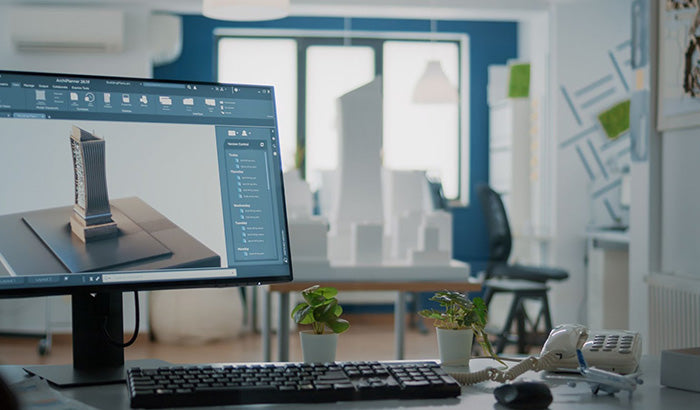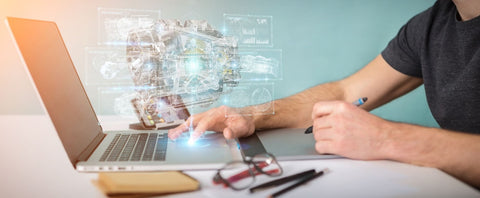The Art of Blueprinting: Bridging Traditional Techniques With Modern Technology

Imagine a world where the old-school charm of hand-drawn sketches meets the lightning-fast precision of today's coolest tech. That's the magic of modern blueprinting.
You arrive in a high-speed, digital age where computers handle the heavy lifting. Here, everything becomes faster, sharper, and a lot more fun. This blend of tradition and technology isn't simply about making things quicker or easier; it's about pushing the boundaries of what we can dream up and build, turning wild ideas into real-life wonders.
Welcome to the art of blueprinting, where the past and the future collide to create the buildings, bridges, and gadgets of tomorrow.
In this dynamic era, the tools of the trade have evolved, but the soul of blueprinting remains. Imagine drafting tables equipped with digital pens that capture the essence of your hand's movement, blending it seamlessly with the endless possibilities of digital editing and simulation.
This innovation means that a single idea can travel through time, from the raw, tactile feel of sketching on paper to the sophisticated simulations run by powerful software, predicting how a structure will withstand the tests of time and nature. It's a world where the artist meets the engineer, where creativity intersects with analysis, making blueprinting not merely a task, but a thrilling adventure in creation.
The collaboration that modern blueprinting fosters is unparalleled. With cloud-based platforms, a drafter in one part of the world can share an idea with an engineer across the globe in seconds, inviting inputs, critiques, and enhancements.
This level of connectivity speeds up the design process; it enriches it, drawing on a diverse pool of knowledge and experience.
Each project becomes a tapestry woven from the threads of countless contributors, each adding their unique touch. In this way, blueprinting becomes more than a means to an end — it becomes a communal act of creation, connecting minds and hearts in the pursuit of innovation.
Let's dive into how this fascinating mix is shaping our world, one blueprint at a time.
From pencil to pixel: The evolution of blueprinting tools
Long ago, draftsmen would spend countless hours over their drawing boards, rulers, and pencils in hand, crafting detailed plans for buildings, machines, and bridges. These drawings weren't only technical; they were works of art. However, the process was slow and prone to human error.
Fast forward to today, and software has transformed blueprinting into a precise, efficient, and versatile practice. Software programs allow for intricate designs to come to life with a few clicks and strokes on a keyboard. Yet, the transition wasn't overnight. It required skilled professionals to adapt and merge their traditional expertise with these new tools.
This shift from manual to digital has streamlined the design process and opened up a world of possibilities that were once beyond imagination. Now, designers can easily modify and perfect their work without starting from scratch, saving time and resources.
The ability to share and collaborate on designs in real-time across the globe has fostered a more connected and dynamic industry. Digital tools have introduced unprecedented realism to blueprints, allowing for 3D modeling and virtual walkthroughs that bring ideas to life before any physical work begins.
This evolution from pencil to pixel has not only changed how we create; it has expanded the boundaries of what we can dream and build.

The heart of blueprinting: It's all about precision
Precision is the heart of all blueprinting work, whether you're working with a pencil or a mouse. Traditional techniques taught drafters the importance of accuracy, scale, and attention to detail. These lessons are still relevant in the digital age.
Modern software might automate calculations and renderings, but the human touch guides these processes, ensuring that each blueprint is accurate, practical, and aesthetically pleasing.
This unwavering commitment to precision enhances the final product's quality and fosters a culture of excellence within the industry. As technology evolves, the tools at our disposal become more sophisticated, enabling even greater accuracy and detail in our work. Yet, the drafter's skill in wielding these tools truly makes the difference.
The meticulous care taken in aligning each line and curve, whether by hand or through software, reflects a dedication to crafting spaces and structures that meet the highest standards of quality and functionality.
In this way, precision serves as both a fundamental principle and a benchmark for success in the art of blueprinting, uniting tradition and innovation in the pursuit of perfection.
Bridging the gap: Traditional skills in a digital world
One might think that the old ways of blueprinting are becoming obsolete, but that's far from the truth. In fact, traditional skills are more valuable than ever. Understanding the fundamentals of drafting by hand gives modern drafters a deeper appreciation and insight into their digital work.
It's like knowing how to do long division even though you have a calculator. This knowledge allows for better problem-solving and creativity, as drafters can envision the final product in both a tactile and a virtual sense.
The tactile experience of traditional blueprinting offers a unique way to connect with the project, grounding designers in the physical world even as they navigate digital spaces. This connection can lead to a richer, more intuitive design process where ideas flow freely between the hand and the screen.
By mastering both realms, drafters and designers unlock a level of versatility and innovation that sets them apart in their field. They become adept at translating the slightest nuance from a hand-drawn sketch into their digital designs, ensuring that every project benefits from a depth of thought and a touch of humanity that technology alone cannot replicate.
The role of technology: More than a tool
Today's technology does more than speed up the blueprinting process. It allows for innovation on a scale previously unimaginable. 3D printing, for example, has taken the concept of the blueprint and brought it into the physical world in a way that hand-drawing never could.
Architects and engineers can create tangible models of their designs, experimenting with materials, structures, and forms in real-time. Virtual reality (VR) and augmented reality (AR) take this a step further, offering immersive experiences that help creators and clients visualize projects in unprecedented detail.
Beyond these remarkable capabilities, technology also serves as a bridge to sustainability and efficiency in the construction and design industries. With advanced simulation software, professionals can now predict and optimize the environmental impact of their projects, reducing waste and energy consumption.
Tools like Building Information Modeling (BIM) enable teams to manage the design and construction process, maintenance, and even demolition with incredible precision and foresight. This holistic approach not only streamlines project execution but also contributes to a more sustainable world.
Thus, technology in blueprinting revolutionizes how we design; it transforms our relationship with the built environment, making it smarter, greener, and more connected.

The future of blueprinting: A blend of old and new
As we look to the future, the field of blueprinting stands at the crossroads of tradition and innovation. Educational programs are starting to recognize this, teaching both hand-drawing techniques and computer-aided design (CAD) software. This dual approach prepares the next generation of drafters, architects, and engineers to respect the past while embracing the future.
This evolving landscape encourages a collaborative spirit among professionals, bridging gaps between generations and disciplines. Engineers, architects, and artists now find common ground in projects that require a melding of technical precision and creative vision.
This synergy fosters groundbreaking designs and a deeper understanding and appreciation for each other's crafts. By embracing both the tactile satisfaction of drawing by hand and the boundless possibilities offered by digital tools, the blueprinting community sets the stage for an era where innovation is limitless, and every line drawn or pixel placed tells a story of unity and progress.
So, here we are, standing at the crossroads of history and the future, where the solid foundations of traditional blueprinting meet the sky-high possibilities of modern technology. It's not about choosing between the old ways and the new; it's about combining the best of both worlds.
This incredible mix lets us dream bigger, build faster, and push the limits of what's possible. As we move forward, remember that every great building, bridge, or gadget starts with a blueprint. And now, those blueprints are more powerful than ever, fueled by the skills of the past and the innovations of the present.
Whether sketching your first line or coding your latest design, you're part of a thrilling story where creativity knows no bounds. Welcome to the future of blueprinting, where your wildest dreams don't merely come to life; they soar.
Discover Your Blueprinting Solutions With Prosoft
Portable drafting stations are transforming blueprinting in every sector, providing unmatched mobility, boosting efficiency, offering cutting-edge CAD features, and much more. These robust stations are setting new standards for what can be achieved in varied and demanding settings, ensuring that professionals have what they need to excel.
ProSoft is your premier choice for superior portable drafting stations and CAD solutions. We recognize the unique challenges of blueprinting projects and present a variety of products engineered to tackle these challenges effectively.
We invite you to browse our high-caliber workstations, crafted to enhance your blueprinting tasks. ProSoft enhances your blueprinting process with the finest technology and innovation. Contact ProSoft today to discover the ideal tools to upgrade your blueprinting projects.
